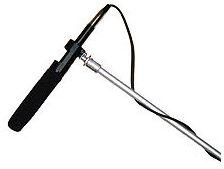Boom Microphones: Tips on Buying Your Own Shotgun Microphones for Boom Operation
Finding the Right Boom Microphone

Boom microphones are the key audio recording component for narrative film projection because of its ability to adequately capture sound from a broader location, which means you can get the audio from an entire scene with a single microphone. Boom microphones are then going to act as the foundation for your audio equipment and you have to find one that is going to meet your production needs. When you are looking at boom microphones there are a few things that you are going to need to look for so that you spend your money correctly and get the audio equipment you wanted.
Accessories
The overall cost of boom microphones are not just in the microphone itself, but also along with what you are going to need to purchase with it. First off, you are going to need to get a “Zeppelin” cover to cradle the shotgun microphone in. This will allow the microphone to remain protected from excessive sound and side suspended within a cover with limited physical contact to the microphone itself. Beyond this you will want to get what is referred to as a “dead cat,” which is a slip cover that will go over the Zeppelin to reduce wind noise even more so. This is called this because it is essentially fury and will actually look like a small animal from a distance. One of the more obvious expenses is the boom pole, and this is also not a place that you should really skimp the money.
Choosing the Microphone
Selecting the right boom microphones are really going to depend on the type of scenes that you are filming and what you need to get out of your sound. A long boom microphone is going to be a good all purpose option for larger scenes with more movement, but they are fairly large in general and will require a very sufficient boom operator. Interiors are not always the best location for a long shotgun microphone, and you may want to get a short shotgun microphone for tighter locations with a lot of sound reverberation.
The microphone’s pick up, or polar pattern, is also going to dictate how the sound is going to be picked up by the microphone. Cardioid microphones of different stripes are going to give you a direction pick up pattern of around ninety degrees from the tip of the microphone, which means that the front of a cardioid microphone has to be pointed at the sound source. Omni microphones have a more general pick up pattern all around the microphone, which means that it will get a larger range of sound than cardioid microphones. This will be best for a lot of intended sound sources in a scene, but also means that it will pick up a lot more background noise.
Purchasing
Shotgun microphones are not something that always needs to be brand specific and you do not need to spend an obscene amount of money to get usable equipment, but you may want to still approach it as a reasonable investment. First, you need to compare the amount of money you will spend on your boom microphones to what you spent on your video equipment more broadly. This means that how much you are going to spend needs to be reflective of the overall production value that you want, but you have to still remember that interrupted audio is not something that is easily fixed. The other thing you want to remembers is to by the components individually and not in a set that includes everything, unless you just need a cheap and easy option and are not concerned with professional quality. Buy the microphone, balanced XLR cables, sound mixer, and boom pole as individual items so that you ensure the specifics and quality of each one.
The boom microphones themselves can be selected by name only if you are going to commit to the cost presented by each one. The Neumann KM 185 and the Schoeps CMC641 are going to be great choices if you really want to spend the money. Since these items can be high impact during use try to only focus on new ones and get protective carrying cases to secure them. Since you are likely going to get other types of microphones, such as wireless microphones, you have to make sure to not blow your entire budget.
References
Source: Author’s own experience.
This post is part of the series: Boom Microphones
Here is a look at different aspects of working with boom microphones.